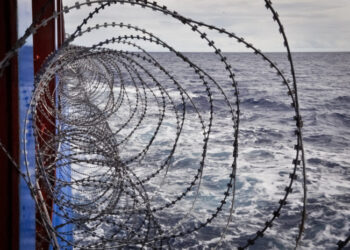The US Navy stated that on Tuesday, November 19, the Abraham Lincoln Carrier Strike Group (ABECSG) completed a scheduled transit through the Strait of Hormuz and into the Arabian Gulf.
Rear Adm. Michael Boyle, commander, Carrier Strike Group (CSG) 12 said that “I’m incredibly proud of the Abraham Lincoln Strike Group Sailors and the professionalism they have demonstrated throughout this deployment,” further commenting that
Especially in evolutions like a Strait transit, where detailed planning, precision navigation and the proficiency of our warfighting teams are on full display.
Namely, the ABECSG is deployed to the U.S. 5th Fleet AOO in support of naval operations in order to ensure maritime stability and security in the Central Region, connecting the Mediterranean and the Pacific through the western Indian Ocean and three strategic choke points.
[smlsubform prepend=”GET THE SAFETY4SEA IN YOUR INBOX!” showname=false emailtxt=”” emailholder=”Enter your email address” showsubmit=true submittxt=”Submit” jsthanks=false thankyou=”Thank you for subscribing to our mailing list”]
ABECSG’s presence in the U.S. 5th Fleet area of operations since May demonstrates the United States’ and its regional partners’ commitment to the free flow of commerce, regional maritime security and freedom of navigation.
What is more, the deployed strike group assets include staffs, ships and aircraft of CSG 12, Destroyer Squadron (DESRON) 2, the guided-missile cruiser USS Leyte Gulf (CG 55) and Carrier Air Wing (CVW) 7, with Abraham Lincoln as the flagship.
Capt. Walter Slaughter, commanding officer of USS Abraham Lincoln (CVN 72), the flagship of ABESG said that
We place ourselves where we need to be, when we need to be there, in order to meet the full range of maritime security requirements of the mission at hand.
In fact, the U.S. 5th Fleet AOO covers almost 2.5 million square miles of water including the Arabian Gulf, Gulf of Oman, Red Sea and parts of the Indian Ocean. The expanse consists of 20 countries and includes three critical choke points at the Strait of Hormuz, the Suez Canal and the Strait of Bab al Mandeb at the southern tip of Yemen.
Notably, the Strait of Hormuz is one of the busiest shipping lanes in the world, with one-fifth of the world’s energy supply going through the strait every year, establishing it crucial for ensuring and safeguarding the stability of global commerce.
Six attacks against commercial vessels, the shoot-downs of a US Navy and an Iranian drone and the seizure of the UK-flagged ‘Stena Impero’ by Iranian authorities have caused disruption over the last months in the Strait of Hormuz, the major shipping route for world oil supply.
Further to this, in August, reports by CNN have suggested that ships sailing in the region have reported unusual GPS interference, among other problems.





































![]](https://safety4sea.com/wp-content/uploads/2024/06/shutterstock_2318996555-350x250.jpg)
























